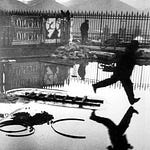I was sitting outside a robotics lab at the North Carolina School of Science & Math. My son was in the lab, where a team of children used a few motors and wheels to fling a foam torus across the lab at dangerous speeds. One of them fed the thingies into the whizzing wheels with her bare hands while wearing safety glasses.
I was not inside the lab because I had to attend a chemistry lecture online. So, I sat in the lobby with my iPad and some headphones to dull the thwack of the foam torus and the cries of injured children.
The course I am taking is called “Introduction to Chemistry,” and chapter two is quite basic. My professor was discussing the history of doing dangerous things for science, particularly the dangerous things people did to figure out what an atom was like.
Early on, a British physicist named J.J. Thomson developed an idea known as the “plum pudding model.” Thomson’s hypothesis was that electrons were like raisins spread around in a big atomic cake of positive charge that resembled a British pastry called a plum pudding, which, in keeping with scientific naming conventions, is not a pudding and does not have plums in it unless you’re British, at which point you can assume that everyone in the world understands your inconsistent version of an inconsistent language that has, for better or worse, become the international language of physics.
I digress. In fact, this entire piece is about how I digress.
In discussing the history of all the fun and dangerous things scientists have done to discover what atoms are like, one must next talk about the Rutherford gold foil experiment. In short, a Japanese physicist named Hantaro Nagaoka rejected the plum pudding model for scientific reasons relating to charge, but also perhaps because it was actually a cake made with raisins and should be called “raisin cake.” Ernest Rutherford, a New Zealander who probably called the dessert something like “jacky woptogs,” decided he would f*** around and find out.
Rutherford, who loved lead boxes and uranium, put some uranium in a lead box. One side of the box had a hole so particles could escape as the radioactive uranium decayed. Everyone wore safety glasses. They pointed the hole at a thin sheet of gold foil, which was surrounded by a circular screen coated with zinc sulfide. The zinc sulfide emitted a little flash of light every time it was hit by an alpha particle, which, in keeping with scientific naming conventions, is not a particle; it’s actually two protons and two neutrons bound together by the strongest force in the universe, which, in a rare lucid moment, physicists named “the strong force.” If you recognize this little bundle of particles, that’s because it’s also the nucleus of a helium atom, and all the helium on earth is produced this way by radioactive minerals. Yes, the thing in a party balloon that makes your voice sound funny was once part of the thing that makes an atom bomb, and not so long ago.
So, Rutherford had a box of the atom bomb stuff that was slowly but quite dramatically making the party balloon stuff. He and his assistant Hans Geiger — yes, that Geiger — turned the lights off and sat with this little chunk of uranium until their eyes became accustomed to the dark and they could see the tiny flashes of light that the radioactive particles made on the zinc sulfide screen. They saw that most of the particles flew straight through the foil, some were deflected by a tiny amount, a rare few bounced off the foil and landed on the side where they were emitted, and presumably, some ripped through Rutherford and Geiger’s DNA, encouraging interesting mutations.
My professor told us about this as I tried to ignore the muted screams in the next room where my precious child was doing science. And then, as I was reading the PowerPoint slide, everything went quiet in my brain. In cold Arial font, it said, “Alpha particle velocity ~1.4 x 10^7 m/s (5% of the speed of light).”
If you are American, I’m sure you’re aware that the speed of light is 3,273,600 football fields per second. If we convert that to standard units, which, in keeping with scientific naming conventions, almost no one uses, 5% is about 33.5 million miles per hour. “5% of the speed of light” is not a detail you think of being hidden away in parentheses.
I missed everything the professor said for the next five minutes. I knew this wasn’t the class to ask the questions I had. Like:
Does an alpha particle go from zero to 33.5 x 10^6 mph instantly? Does the classical concept of acceleration make sense at this level? Two protons and two neutrons together could be large enough to have a fuzzy center of mass, right? This isn’t just one question, is it?
Does this hurt the gold atom?
What’s our health insurance deductible?
An alpha particle has an atomic mass of 4. A gold atom has an atomic mass of just under 200. Imagine a 4-kilogram weight traveling at 33,550,000 miles per hour and hitting something that weighs 200 kilograms. An alpha particle traveling this unimaginable speed hits a gold nucleus and bounces off.
Rutherford said, “It was like firing a 16" shell at a tissue paper and having it bounce back at you.”
In the chaos of my online class, accompanied by the firing, thumping, and squealing of teenage scientists in the next room, I had my own sort of eureka moment. Until that second, I hadn’t been as interested in quantum mechanics as I was in relativity physics. Maybe it’s because you can see moons, apples, and foam toruses, and you can either throw them at things or throw things at them. A raisin cake, even at 5% the speed of light, is a raisin cake.
The subatomic world is built differently.
I snapped out of my quantum reverie. In “Introduction to Chemistry,” my professor had moved on to Sir James Chadwick, who was firing alpha particles at beryllium to discover neutrons. My son emerged from the lab, grinning, holding a broken piece of plexiglass, and wearing his safety glasses.














Share this post